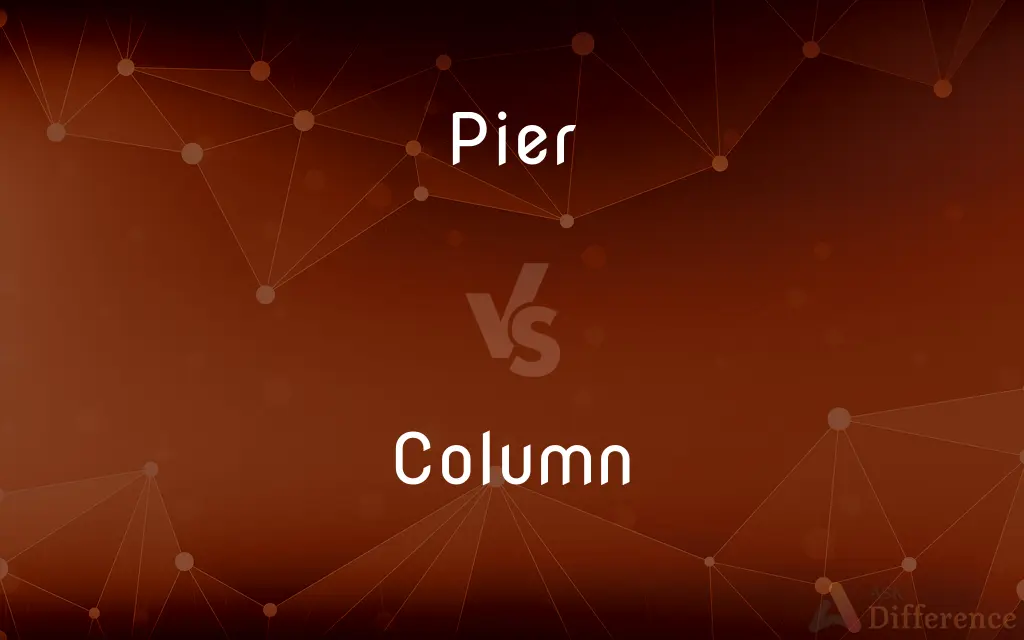Pier vs. Column — What's the Difference?
By Urooj Arif & Fiza Rafique — Updated on March 11, 2024
A pier is a support structure extending into water for docking, while a column is a vertical support in buildings.

Difference Between Pier and Column
Table of Contents
ADVERTISEMENT
Key Differences
Piers are primarily used as part of architectural structures extending into bodies of water to accommodate boats and ships, providing mooring or passage. Columns, on the other hand, are essential elements in construction, designed to support the weight of a building above them.
While piers project outward from the land into water, allowing access beyond the immediate coast, columns are integral to the structure of buildings, supporting roofs or other architectural elements. Piers facilitate human interaction with water environments, providing platforms for activities such as fishing, dining, or leisure. Columns, however, are predominantly about utility and aesthetics within the construction, crucial for the structural integrity and design of buildings and monuments.
Piers are subject to environmental factors like tides, currents, and saltwater corrosion, requiring materials and designs that can withstand such conditions. In contrast, columns are designed with consideration for load-bearing, seismic activity, and the material's compatibility with the rest of the structure, highlighting the different engineering challenges each faces.
The design and construction of piers emphasize resilience against environmental challenges and functionality for specific water-related activities. Conversely, columns focus on architectural beauty, structural integrity, and the seamless integration into the overall design of buildings, reflecting the diverse purposes and challenges inherent in constructing piers and columns.
Comparison Chart
Primary Use
Docking and recreational activities in water.
Supporting structures and architectural aesthetics in buildings.
ADVERTISEMENT
Location
Extends from land into water.
Found within the structure of buildings.
Material
Wood, metal, concrete, depending on environmental needs.
Stone, concrete, metal, tailored to architectural requirements.
Design Challenges
Must withstand environmental factors like tides and corrosion.
Load-bearing, seismic considerations, aesthetic contribution to architecture.
Function
Facilitates interaction with water environments.
Ensures structural integrity and contributes to aesthetic appeal.
Compare with Definitions
Pier
A platform extending from the shore into the water, supporting structures above it.
The fishermen gathered at the pier's end to catch the early morning tide.
Column
A vertical structural element that supports weight from above.
The ancient columns still stand tall, holding up the temple's roof.
Pier
A support for bridges over water.
The engineers are assessing the condition of the bridge's piers.
Column
An element of classical architecture.
The museum's Greek exhibit showcases replicas of Ionic columns.
Pier
A reinforced structure extending into a body of water.
The old wooden pier has stood against countless storms.
Column
A load-bearing pillar made of stone, concrete, or metal.
The new library features steel columns for a modern look.
Pier
A structure used for docking ships and boats.
The cruise ship docked at the newly built pier.
Column
An architectural feature contributing to the aesthetics of buildings.
The Corinthian columns added elegance to the courthouse facade.
Pier
A recreational area extending over water.
The city's pier is a popular spot for evening walks.
Column
A cylindrical post serving as a support in buildings.
The lobby's columns were adorned with intricate carvings.
Pier
A pier is a raised structure that rises above a body of water and usually juts out from its shore, typically supported by piles or pillars, and provides above-water access to offshore areas. Frequent pier uses include fishing, boat docking and access for both passengers and cargo, and oceanside recreation.
Column
A column or pillar in architecture and structural engineering is a structural element that transmits, through compression, the weight of the structure above to other structural elements below. In other words, a column is a compression member.
Pier
A platform extending from a shore over water and supported by piles or pillars, used to secure, protect, and provide access to ships or boats.
Column
A vertical structure usually consisting of a base, a cylindrical shaft, and a capital, used as a support or standing alone as a monument.
Pier
Such a structure used predominantly for entertainment.
Column
Any slender vertical support, as of steel or reinforced concrete.
Pier
A supporting structure at the junction of connecting spans of a bridge.
Column
Something resembling an architectural column in form or function
A column of mercury in a thermometer.
Pier
A pillar, generally rectangular in cross section, supporting an arch or roof.
Column
One of two or more vertical sections of text lying side by side in a document and separated by a rule or a blank space.
Pier
The portion of a wall between windows, doors, or other openings.
Column
An arrangement of numbers in a single vertical line.
Pier
A reinforcing structure that projects from a wall; a buttress.
Column
A feature article that appears regularly in a publication, such as a newspaper.
Pier
A raised platform built from the shore out over water, supported on piles; used to secure, or provide access to shipping; a jetty.
Your boat is docked at the pier.
Column
A formation, as of troops or vehicles, in which all elements follow one behind the other.
Pier
A similar structure, especially at a seaside resort, used to provide entertainment.
There is a gaming arcade on the pier.
Column
(Botany)A columnlike structure, especially one formed by the union of a stamen and the style in an orchid flower, or one formed by the united staminal filaments in flowers such as those of the hibiscus or mallow.
Pier
A structure supporting the junction between two spans of a bridge.
Column
(Anatomy)Any of various tubular or pillarlike supporting structures in the body, each generally having a single tissue origin and function
The vertebral column.
Pier
(architecture) A rectangular pillar, or similar structure, that supports an arch, wall or roof, or the hinges of a gate.
Column
(architecture) A solid upright structure designed usually to support a larger structure above it, such as a roof or horizontal beam, but sometimes for decoration.
Pier
Any detached mass of masonry, whether insulated or supporting one side of an arch or lintel, as of a bridge; the piece of wall between two openings.
Column
A vertical line of entries in a table, usually read from top to bottom.
Pier
A projecting wharf or landing place.
Column
A body of troops or army vehicles, usually strung out along a road.
Pier
A platform built out from the shore into the water and supported by piles; provides access to ships and boats
Column
A body of text meant to be read line by line, especially in printed material that has multiple adjacent such on a single page.
It was too hard to read the text across the whole page, so I split it into two columns.
Pier
(architecture) a vertical supporting structure (as a portion of wall between two doors or windows)
Column
A unit of width, especially of advertisements, in a periodical, equivalent to the width of a usual column of text.
Each column inch costs $300 a week; this ad is four columns by three inches, so will run $3600 a week.
Pier
A support for two adjacent bridge spans
Column
(by extension) A recurring feature in a periodical, especially an opinion piece, especially by a single author or small rotating group of authors, or on a single theme.
His initial foray into print media was as the author of a weekly column in his elementary-school newspaper.
Column
Something having similar vertical form or structure to the things mentioned above, such as a spinal column.
Column
(botany) The gynostemium
Column
(chemistry) An object used to separate the different components of a liquid or to purify chemical compounds.
Column
A kind of pillar; a cylindrical or polygonal support for a roof, ceiling, statue, etc., somewhat ornamented, and usually composed of base, shaft, and capital. See Order.
Column
Anything resembling, in form or position, a column in architecture; an upright body or mass; a shaft or obelisk; as, a column of air, of water, of mercury, etc.; the Column Vendôme; the spinal column.
Column
A body of troops formed in ranks, one behind the other; - contradistinguished from line. Compare Ploy, and Deploy.
Column
A number of ships so arranged as to follow one another in single or double file or in squadrons; - in distinction from "line", where they are side by side.
Column
A perpendicular set of lines, not extending across the page, and separated from other matter by a rule or blank space; as, a column in a newspaper.
Column
A perpendicular line of figures.
Column
The body formed by the union of the stamens in the Mallow family, or of the stamens and pistil in the orchids.
Column
One of a series of articles written in a periodical, usually under the same title and at regular intervals; it may be written and signed by one or more authors, or may appear pseudonymously or anonymously, as an editorial column.
Column
A line of (usually military) units following one after another
Column
A vertical glass tube used in column chromatography; a mixture is poured in the top and washed through a stationary substance where components of the mixture are adsorbed selectively to form colored bands
Column
A linear array of numbers one above another
Column
Anything tall and thin approximating the shape of a column or tower;
The test tube held a column of white powder
A tower of dust rose above the horizon
A thin pillar of smoke betrayed their campsite
Column
An article giving opinions or perspectives
Column
A vertical structure standing alone and not supporting anything (as a monument or a column of air)
Column
(architeture) a tall cylindrical vertical upright and used to support a structure
Common Curiosities
How do columns contribute to a building's structure?
They support the weight of the building, transferring loads to the foundation.
In what architectural styles are columns found?
Doric, Ionic, Corinthian, among others, reflecting different historical and cultural influences.
Can piers be used for purposes other than docking?
Yes, they often serve as recreational spaces for activities like fishing, walking, and dining.
What factors influence the design of a column?
Load-bearing capacity, seismic activity, architectural aesthetics, and material compatibility.
What is the primary function of a pier?
To provide docking for boats and ships, and serve as recreational spaces over water.
What materials are commonly used for constructing piers?
Wood, metal, and concrete, chosen based on environmental conditions and durability requirements.
What challenges do engineers face when designing piers?
They must ensure the pier's durability and stability against environmental conditions.
How does the environment affect pier construction?
Piers must withstand environmental challenges such as tides, currents, and corrosion.
What is the significance of column shapes?
The shape affects the column's load-bearing capacity and aesthetic appeal.
Can columns be purely decorative?
Yes, some columns serve as decorative elements without supporting any load.
What is the difference between a pier and a wharf?
A pier extends into the water for docking, while a wharf is a parallel structure along the shore.
Are piers always constructed over water?
Yes, piers are specifically designed to extend into bodies of water.
How do columns affect the aesthetic of a building?
They significantly contribute to the building's architectural beauty and style.
How are columns integrated into modern architecture?
They are used for both structural support and to enhance architectural aesthetics.
What are some common uses for piers?
Docking, recreational activities, and as support structures for bridges.
Share Your Discovery

Previous Comparison
State vs. Condition
Next Comparison
Elf vs. DwarfAuthor Spotlight
Written by
Urooj ArifUrooj is a skilled content writer at Ask Difference, known for her exceptional ability to simplify complex topics into engaging and informative content. With a passion for research and a flair for clear, concise writing, she consistently delivers articles that resonate with our diverse audience.
Co-written by
Fiza RafiqueFiza Rafique is a skilled content writer at AskDifference.com, where she meticulously refines and enhances written pieces. Drawing from her vast editorial expertise, Fiza ensures clarity, accuracy, and precision in every article. Passionate about language, she continually seeks to elevate the quality of content for readers worldwide.














































